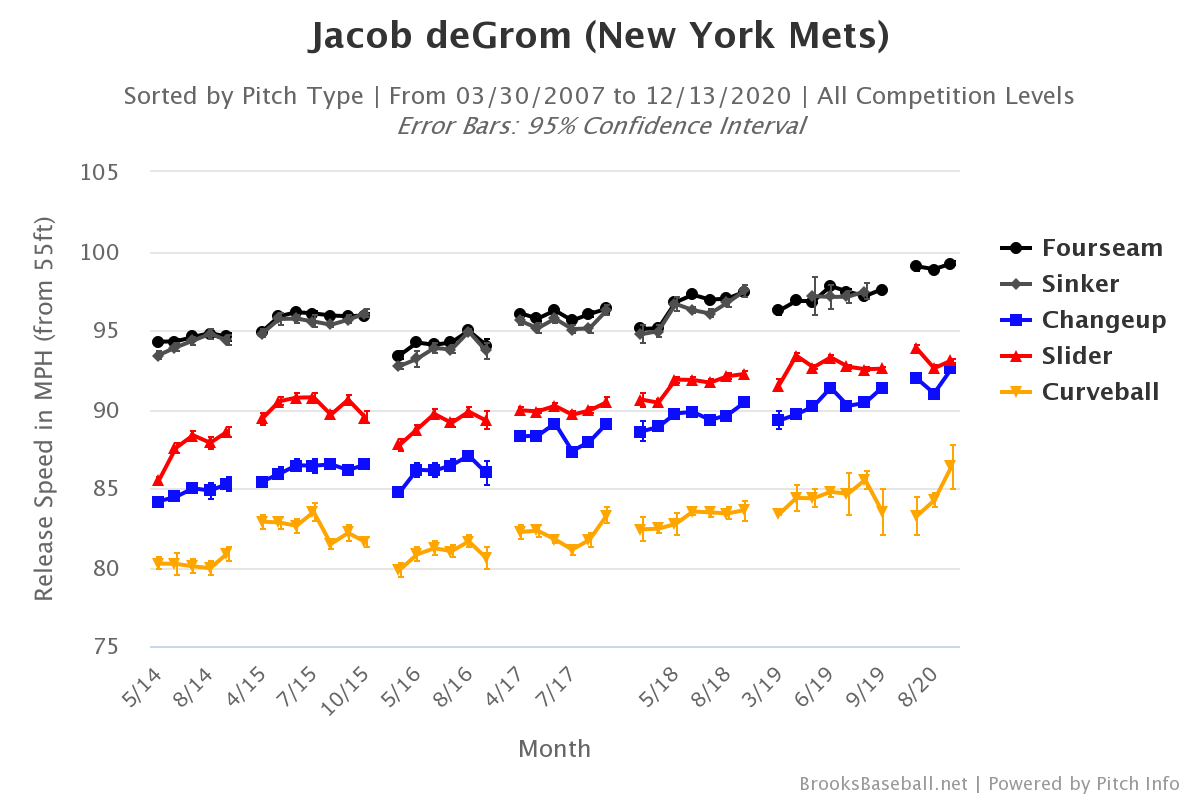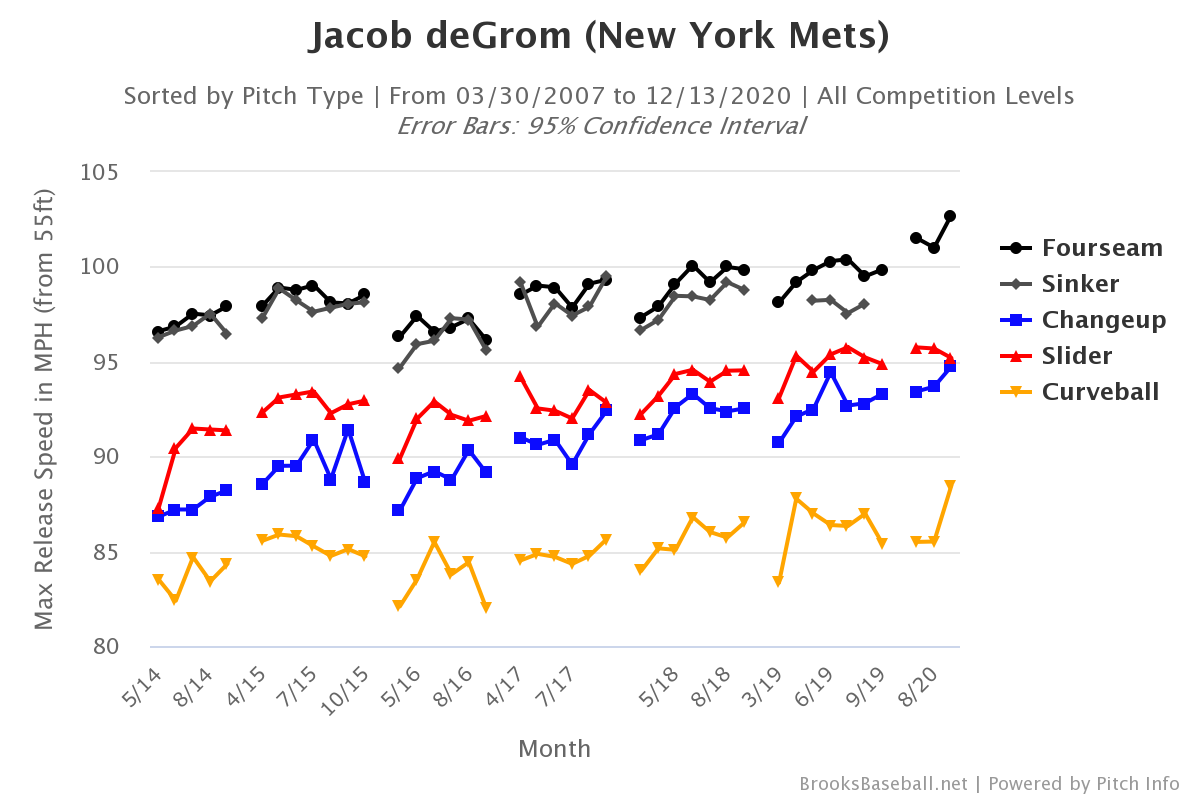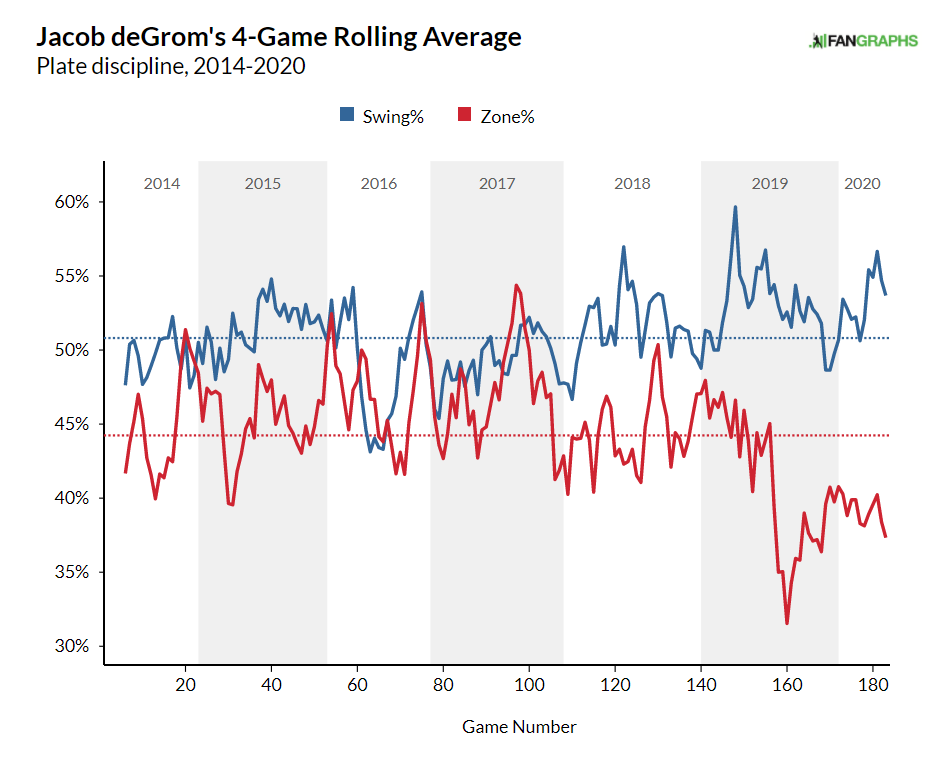Jacob deGrom has spent a lot of time being a pitcher that is very good. That feels like a weird thing to say, but it’s true! Since 2014, deGrom ranks third of all pitchers in fWAR, trailing only Max Scherzer and Clayton Kershaw. Since 2017, he ranks first! To me, there’s something about deGrom where it feels like he’s flying under the radar. Maybe it’s something about him. Maybe it’s that he pitches for the Mets. Whatever it may be, I don’t think deGrom receives enough recognition, and so I will recognize him.
Filtering out deGrom’s 2020, here’s how he ranks since 2014, for starters:
- Fourth in fWAR
- Third in FIP
- Ninth in K-BB%
- Eighth in SwStr%
- Eighth in Hard Hit%
By most metrics that we care about, deGrom has been an elite pitcher. That shouldn’t be a surprise to anyone. But now, deGrom has folded in a few new changes that have elevated his game.
We’ll start with his velocity. He increased his average velocity by nearly two ticks:

And, as it follows, also increased his maximum velocity by more than two ticks:

It’s not like deGrom was lacking for velocity before. He hasn’t sat comfortably below 95 mph in a game since 2016, and now he’s sitting at 98 mph while touching 102. He didn’t need this bump in velocity, but now that he’s got it, he’s become stupid good. And hitters haven’t adjusted. (To be fair, how could you?)
Here’s a look at deGrom’s four-game rolling averages for swing percentage and zone percentage:

deGrom has always thrown the ball in the zone a touch above league-average. Now? His zone percentage has plummeted. He ranked in the 20th percentile in zone percentage for starters in 2020, and yet hitters swung at his pitches more than any other starter. Generally speaking, I would make the assumption that, given that deGrom has become a more deceptive pitcher. Given this, you would expect his zone-swing percentage to go down, and his chase percentage to increase. This makes enough sense — hitters don’t know what’s coming, so they swing more at junk and take more pitches in the zone. But this hasn’t been the case at all. In fact, deGrom has not only drawn more chases, but hitters are also swinging at pitches in the zone more too.
To me, I find that the answer lies beneath the surface. Pitching is a very convoluted process, and so there are several, several factors at hand, but I find it most instructive to look at these pitches at the pitch level, but also at how deGrom’s approach has differed as it pertains to batter handedness. The changes I’ll take about date back to 2019, which is when deGrom’s zone percentage numbers started getting whacky.
Against righties is where deGrom has really started to excel, so we’ll start there.
| Fastball | Breaking | Offspeed | |
|---|---|---|---|
| Pre-2020 | 63% | 33% | 3% |
| 2020 | 69% | 29% | 1% |
Everything looks fairly normal here, but within these pitch classifications, a lot has changed. deGrom has completely faded his sinker, increasing his first-pitch four-seam fastball percentage from 49% to 69%, and he’s also increased his first-pitch slider percentage to 29% from 25%. And so, on the first pitch, he’s gone from throwing a four-seam fastball half of the time to over two-thirds of the time.
What I’m most interested in here, though, is how deGrom has approached hitters who are ahead in the count.
| Fastball | Breaking | Offspeed | |
|---|---|---|---|
| Pre-2020 | 63% | 33% | 11% |
| 2020 | 40% | 58% | 2% |
It’s fascinating. deGrom has the hardest fastball of his life, and yet, when hitters are ahead, he’s turning to his slider 57% of the time instead of its previous 28% usage. His fastball usage has remained steady in hitter’s counts, and so, deGrom has (for the most part) simply stopped throwing his curveball and changeup to righties in favor of his slider. Regardless of what you think of deGrom’s heater, this is a good change! Since 2014, his fastball xwOBA is .409 in hitter’s counts, while his slider xwOBA is .312 in hitter’s counts. Hitters are looking fastball in favorable counts, and so this is quite the judicious tweak on deGrom’s end.
Here’s how deGrom has pitched in hitter’s counts in 2020 versus before:

Not only is he throwing something that hitters aren’t expecting as much, but he’s also staying out over the plate far less, throwing more sliders low and away to his glove-side. He’s still throwing to the same areas with his pitches, his overall location has just changed based on the changes inherent in optimizing his pitch mix. It all makes a ton of sense. He has a harder fastball, he’s throwing his best pitches more, and he’s optimizing the counts in which he’s throwing his pitches.
Unfortunately for hitters, deGrom has gotten smarter against lefties too, and in similar ways. First, we’ll consider his first-pitch approach:
| Fastball | Breaking | Offspeed | |
|---|---|---|---|
| Pre-2020 | 59% | 29% | 12% |
| 2020 | 44% | 36% | 19% |
While he’s ramped up the number of first-pitch fastballs he throws against righties, he’s tampered his fastball usage against lefties in favor of more breaking and offspeed pitches. Hitters are becoming more aggressive in first-pitch counts, and so the more you can keep them off-balance the better.
deGrom is leaning into it even harder when hitters are ahead:
| Fastball | Breaking | Offspeed | |
|---|---|---|---|
| Pre-2020 | 54% | 26% | 20% |
| 2020 | 32% | 38% | 30% |
When left-handed hitters are ahead in the count, they have about an even chance (i.e., ~33%) of correctly what type of pitch is coming. It used to be a fastball more than half the time, but now he’s completely scrapped the curveball and has bumped up his slider and changeup usage to match how often he uses his fastball.
How has it affected his outcomes?
- Pre-2020, 0-0: .406 xwOBA, 41.0% CSW
- 2020, 0-0: .407 xwOBA, 40.9% CSW
- Pre-2020, hitter’s counts: .374 xwOBA, 33.7% CSW
- 2020, hitter’s counts: .319 xwOBA, 39.2% CSW
We’ll withhold judgment on deGrom’s first-pitch outcomes for now. Perhaps this is because he gave up just five hits on first-pitch counts in 2020, or perhaps it’s because the numbers don’t support my thinking that he’s improved his first-pitch approach. What we can say with more confidence is that deGrom has improved when he’s behind in the count. He doesn’t spend much time behind in the count, but now when he is, he’s able to mitigate how much of a disadvantage he is at.
This is what good pitchers do. I’m not sure anyone expected the spike in velocity, but regardless of his velocity increase, deGrom has become a better pitcher. Perhaps he has room to grow with his pitch mix against righties in 0-0 counts — it might not be optimal to throw fastballs 69% of the time — but there’s only so much we can nitpick. Especially when he’s made so many good changes already. Jacob deGrom was already special enough, but he’s showing signs of further growth. Even when you think he’s behind, he’s not.
Photo by Brian Rothmuller/Icon Sportswire | Adapted by Doug Carlin (@Bdougals on Twitter)

